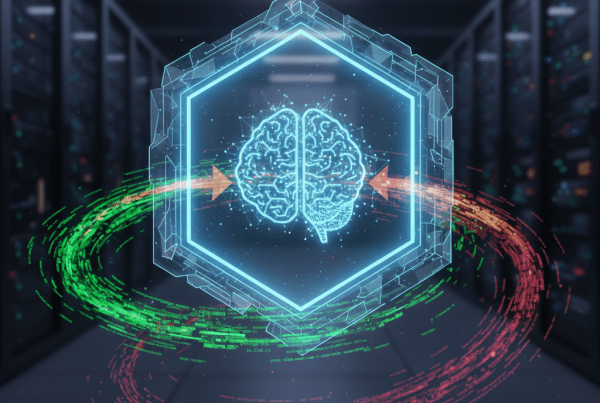Artificial intelligence has quickly become one of the most discussed topics in business. Leaders see its potential to reshape how companies operate, compete, and serve customers. From predictive analytics to automated workflows, AI promises speed, accuracy, and new insights that were out of reach just a few years ago.
But as businesses pursue AI adoption, many run into the same problem: their data isn’t ready. Legacy systems, outdated processes, and fragmented information prevent AI from delivering meaningful results. It’s like trying to power a modern machine with low-grade fuel. Without clean, well-organized, and accessible data, AI tools can’t perform to their potential.
Data modernization is one of the most practical steps in getting value from AI. When companies update their data systems and processes, they give AI the solid foundation it needs to work. This applies to every type of organization, from small businesses to global enterprises. Without modernization, it’s common to see projects stall out, drain budgets, and fail to deliver the results leaders were counting on.
The Hype vs. Reality of AI Adoption
AI adoption is often fueled by excitement. Articles, conferences, and industry peers share bold claims of how AI can cut costs, boost efficiency, and create new opportunities. It is easy to believe that implementing a few AI tools will lead directly to transformation.
The reality is more complicated. AI is not a plug-and-play solution. It requires a steady supply of high-quality data to function effectively. Without it, the most advanced algorithms will still produce inaccurate or inconsistent results. Businesses that jump into AI projects too quickly often find themselves building on weak foundations.
Consider a company launching an AI tool to improve customer service. If the customer data it relies on is incomplete, outdated, or siloed across multiple systems, the tool may provide inaccurate recommendations or fail to recognize customer patterns. Instead of improving the customer experience, it may frustrate both staff and clients.
AI readiness is the real differentiator. Companies must ask whether their data environment can support the goals they have for AI. If not, modernization must come first.

Why Data Modernization Comes First
Data modernization is the process of moving away from legacy, siloed systems toward environments that are integrated, scalable, and easier to manage. It means ensuring data is accurate, accessible, and aligned with business needs. For many organizations, this involves migrating to cloud platforms, consolidating scattered data sources, and introducing stronger governance practices.
The link between modernization and AI is straightforward. AI tools need structured and reliable data. Legacy systems often hold records in outdated formats or keep them locked away in departmental silos. This prevents organizations from gaining a complete view of their information. In addition, most AI applications now demand real-time access. Legacy systems were never designed to deliver this level of responsiveness.
Modernization also creates value beyond AI. It supports regulatory compliance, reduces risks tied to outdated technology, and improves collaboration across teams. When businesses modernize, they are not simply upgrading their IT systems. They are creating a foundation for growth, innovation, and long-term competitiveness.
The Risks of Skipping Modernization
Some organizations push ahead with AI adoption without addressing the condition of their data. This approach carries significant risks.
The most immediate problem is poor results. AI tools that rely on incomplete or inaccurate data will deliver flawed outputs. This creates wasted effort, misinformed decisions, and frustration among teams.
Compliance risks are another concern. Regulations around privacy, security, and data handling are becoming more complex. Legacy systems often lack the governance structures needed to meet these requirements. Implementing AI without addressing these gaps can expose organizations to regulatory penalties.
There are also hidden financial costs. Trying to make outdated systems work with AI often requires custom integrations or temporary fixes. These short-term solutions increase expenses without addressing the root issue.
Perhaps most damaging is the loss of confidence. If leaders and employees see AI projects failing, they may begin to view AI as unreliable or overhyped. This perception can slow future adoption, even after the business takes steps to modernize.
Imagine a business investing in an AI system to forecast sales. If the system draws on inconsistent data from multiple departments, it may produce sales forecasts that are wildly inaccurate. The business ends up making inventory and staffing decisions based on flawed information. Over time, trust in the system declines, and the investment is seen as a failure.
What Modernized Data Looks Like
So, what does modernized data look like in practice? A few key characteristics stand out:
- Unified platforms: Instead of scattered databases and disconnected applications, modernized environments bring data together in a single, integrated system.
- Cloud-enabled scalability: Storage and computing resources can expand or contract as needed, making it easier to handle large or unpredictable data volumes.
- Built-in governance and compliance: Policies and frameworks are in place to ensure data is accurate, consistent, and aligned with regulations.
- Real-time access: Information is available when it is needed, not hours or days later. This supports faster and more confident decision-making.
- Stronger security: Modernized systems are designed with current cybersecurity threats in mind, reducing the risk of breaches or data loss.
When these characteristics are in place, AI can truly add value. Instead of struggling with unreliable inputs, AI tools can analyze patterns, provide insights, and support automation that delivers measurable outcomes.
Modernization also ensures that businesses are not just chasing technology trends. They are aligning their data practices with their overall strategy, which leads to more meaningful progress.

The Organization’s Role in Data Modernization
Data modernization succeeds when it is treated as a company-wide priority. Too often, businesses view it as a project for IT teams alone. In reality, it requires alignment across leadership, operations, and employees.
Organizations must build modernization into their overall strategy. Investments in modern data platforms should be tied to clear business outcomes, such as improving customer experience, unlocking new revenue opportunities, or strengthening risk management.
Change management is equally important. New systems only deliver value if people use them effectively. Leaders should ensure teams understand how modernization supports their work and why adoption matters.
When businesses treat modernization as an ongoing business priority, the benefits extend beyond IT. It improves how teams work today and positions the company to adopt new tools and innovations more effectively in the future.
Steps to Begin Your AI-Ready Data Modernization Journey
Modernization may sound complex, but it can be approached in practical stages. Here are some steps to get started:
- Assess your current state. Identify where your data lives, which systems are outdated, and where gaps or silos exist. This baseline is critical for planning.
- Set business-first goals. Define what you want to achieve. Goals may include better decision-making, faster reporting, or compliance improvements. Clear goals guide technology choices.
- Choose the right platform. Determine whether cloud, hybrid, or on-premise solutions make the most sense based on industry needs and regulations.
- Establish governance and security. Create policies for how data will be managed, monitored, and protected. This ensures accuracy and builds trust in the system.
- Start small and scale up. Select one high-impact project to pilot. Demonstrating success builds momentum and helps secure buy-in for broader modernization.
By following these steps, businesses can move forward without being overwhelmed. Modernization does not need to happen all at once. It is a process that builds over time, each step adding more value and creating more opportunities for AI.
AI Without Data Modernization Is Unsustainable
AI will continue to evolve and place greater demands on business data. Tools will require more accuracy, more speed, and more integration across functions.
Organizations that modernize now will be ready for this future. They will be able to adopt new AI tools more quickly, deliver more reliable results, and gain an edge over competitors that remain stuck in legacy systems. Those that delay modernization will struggle to keep up as AI adoption accelerates around them.
Data modernization is how businesses ensure their AI investments remain valuable as technology continues to advance.
Where the AI Journey Truly Begins
AI can transform the way businesses operate, but it cannot succeed on outdated foundations. Reliable, unified, and secure data is the key to unlocking its potential.
Data modernization gives organizations that foundation. It eliminates silos, improves accuracy, strengthens compliance, and ensures that AI has the fuel it needs to perform. Just as importantly, it aligns technology with business goals, turning AI from a series of experiments into a driver of meaningful results.
About Atlantic, Tomorrow’s Office
Atlantic, Tomorrow’s Office is a leading managed services provider offering managed IT, cybersecurity, office technology, business consulting, and digital transformation solutions. Focusing on helping mid-market businesses optimize their cybersecurity practices, enabling technology and operations, Atlantic delivers end-to-end solutions tailored to the evolving needs of today’s enterprises.
For the latest industry trends and technology insights, visit ATO’s main Blog page.




